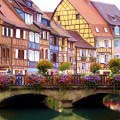





The Region
Looking at the Alsace of today, we may discover that the once embattled territory has regained its well-deserved rest. Peaceful villages, old city walls and sleepy wineries line up along the horizon of the region better known for its fortresses. Not to be missed is the fabulous Alsacian Route du Vin. Along the 180 kilometres of the picturesque wine road one can admire historic town with medieval half-timber houses, cobbled streets and Renaissance fountains.
Read More / Weiter Lesen »
Culture & Sights
The capital of Alsace, Strasbourg, is often – righteously – named the “Europe’s nodal point”. Cosmopolitan atmosphere combines with medieval charm. The cathedral, also named Cathedrale Notre-Dame, is overabundant in sculptures and reliefs, glass paintings and figurines, to mention just one of the most remarkable buildings. The Palais Rohan also fascinates with its royal chambers. The most popular destination in Alsace however is not in its capital – the Château de Haut-Kœnigsbourg. The medieval-looking castle charms the visitor by its breathtaking architecture and wonderful views over the Rhine Plain. The Alsacian Plain is a very good place for daytrips. And if one visits the Saverne with its luxurious castle and rosegarden, or prefers to admire the vineyards of Ribeauville, is their own choice.
Cuisine
Typical for this region are the homely wine tavern serving sauerkraut and white wine. The Alsacian wines are mostly dry and full-bodied. Predominant are white vines; only Pinot Noir becomes red wine. The Gewuerztraminer with its unusual character is the most typical wine, whereas the Riesling is considered to be best. The Muscat is another full-flavoured sort of wine.
The Country and its People
If we were to look for words to describe the Alsacian people, one of these words would be identity awareness. People are proud of their regional customs and keep up their dialects.







